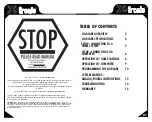
59
Glossary
Decoder
In order to make the digital control signals of the multi
MAUS
understandable to “conventional” technol-
ogy, you require a “translator” – the decoder. It does not replace any of the components in the analogue
direct current locomotive but is a necessary addition and must also be given a place in the locomotive
housing. For alternating current locomotives on the other hand, the change-over module or relay is re-
placed by the decoder, not in DCC format but of course Motorola format.
CVs
All values which affect the behaviour of the locomotive decoder – and ultimately the behaviour of the
locomotive – are stored in what are referred to as CVs. CV is the abbreviation for configuration variables.
You can read and write these CVs as the multi
MAUS
and the Z21 are compatible with the NMRA / DCC
standard.
ROCO amplifiers 10761 and 10764 and booster 10762 and 10765 cannot be used to read the CVs from
a decoder! The values shown are only fictitious suggested values.
CVs range from “0” to “255”. This shows that reprogramming requires experience, as incorrectly set CVs
may have an adverse effect on the performance of the decoder.
Speed steps
On a conventional model railway a regulating transformer is used to control locomotives. The transformer
emits voltage values to control the locomotive motor between 0 volts and the maximum voltage (typically
between 12 and 16 volts) via the controller.
In a digital system on the other hand, the track always carries a fixed constant voltage. The motor is con
-
trolled by the control signals which the decoder converts into voltage values. These signals are made up of
“zeros” and “ones” and are therefore modified. The smaller the steps – speed steps – are, the more ac
-
curately the locomotive can be controlled. The DCC / NMRA standard, according to which the multi
MAUS
works, recognises 14, 27, 28 or 128 speed steps.
Modern decoders (from about 2000 onwards) can be controlled using at least 28 speed steps. They auto-
matically set to the number of speed steps set in the locomotive controller (i.e. the multi
MAUS
) so that
you do not need to make the setting in the decoder yourself. See the respective operating manual to
determine whether your decoder is compatible with automatic speed step setting and which speed steps
your decoder accepts.
Smart-Search function
The multi
MAUS
has a
smart search function
, which provides assistance when searching for an locomo-
tive. The function is available in both library mode and locomotive address mode.
Each locomotive address which you call up while using the system is entered into the internal smart search
list. If you search for a locomotive by pressing one of the arrow keys, the search procedure briefly stops on
each locomotive in the list. This way, you can find the locomotives you have used very quickly.
A maximum of 32 locomotives can be included in the list of smart search addresses. The list is of no benefit
for a single locomotive. If you have called up more locomotives than what fits in the list, the oldest loco
-
motive is deleted from the list. You delete all smart search addresses by restarting the system (disconnect
power supply or unplug the master multi
MAUS
).
You activate the smart search function using the menu item “USERINTERFACE” (see page 55, 3.2.5.).
8051281925.indd 59
10.05.2016 12:52:19
Содержание MultiMAUS
Страница 63: ...63 8051281925 indd 63 10 05 2016 12 52 19 ...
Страница 95: ...95 8051281925 indd 95 10 05 2016 12 52 24 ...
Страница 126: ...126 126 8051281925 indd 126 10 05 2016 12 52 29 ...
Страница 127: ...127 8051281925 indd 127 10 05 2016 12 52 29 ...
















































